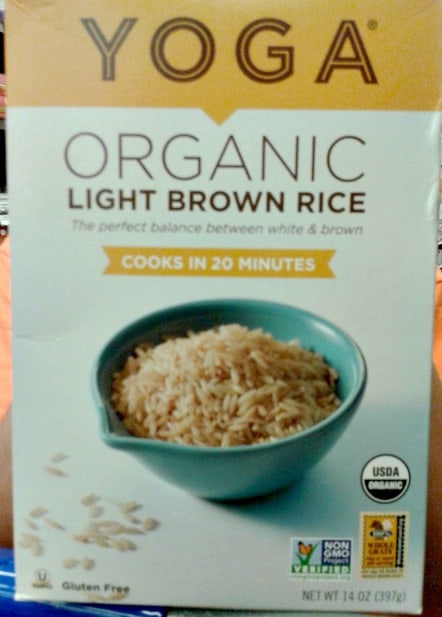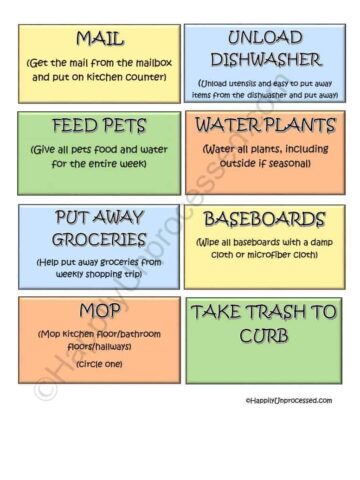I came across something very interesting today that I wanted to share with you.
Since we have gone unprocessed in 2012 we continue to decrease the amount of foods we eat which contain white flour and white sugar all the time, this means less spaghetti, noodles, and pastas. I will be open and honest here and say it hasn’t been easy, but at least my family is now open to other alternatives besides refined sugars and flours.
As an alternative we have been turning more towards rice and I am always intrigued at how many variations of rice there are on the shelves. I just wanted to point out some of the more common ones we see:
Some types of rice
- LONG GRAIN~ Long grain rice has a long, slender kernel, four to five times longer than its width. It is usually light and fluffy in texture.
- MEDIUM GRAIN~ Medium grain rice has a shorter, wider kernel (two to three times longer than its width) than long grain rice. Tends to cling.
- SHORT GRAIN~ Short grain rice has a short, plump, almost round kernel. Soft and clingy.
- BROWN RICE ~ Only the outermost layer, the hull, is removed to produce what we call brown rice. This process is the least damaging to the nutritional value of the rice and avoids the unnecessary loss of nutrients that occurs with further processing.
- BASAMTI ~ Often confused with Jasmine rice, Basmati rice comes from the foothills of northern India and Pakistan. It needs to be soaked for at least 30 min prior to cooking.
- RED RICE~ This long-grain rice has a reddish bran layer and a nutty, complex flavor.
- BLACK RICE~ Chinese Black Rice is a medium-grain rice with white kernels inside the black bran. Cooked, it takes on a deep purplish color.
- WHITE RICE~ The process that converts brown rice into white rice destroys 67% of the vitamin B3, 80% of the vitamin B1, 90% of the vitamin B6, half of the manganese, half of the phosphorus, 60% of the iron found in brown rice.
Then I came across this…
So during my meandering of the rice section, I came across this organic light brown rice by Yoga, which poses a good question ….
Does rice need to be organic or can you buy conventional?
According to the OrganicPrepper.com and What’s in my Food?, “the pesticide load on conventionally grown rice is tremendous.”
I don’t know a whole lot about rice and how it’s cultivated so I decided to do a little research.
Where does rice come from?
Rice is typically grown in countries with low labor costs and high rainfall, as growing rice is very labor intensive. It is most commonly grown in Asia and parts of Africa. The conditions need to be very wet and/or moist. Traditionally after the seeds are planted the fields are flooded.
Today in America new technology has enabled farmers not to rely on heavy rainfall and mother nature as much by using soil that has a clay base because it has poor drainage. The rice is then sprayed with fertilizers and pesticides by the plane full.
Regardless of whether the rice is grown in another country or here at home, it will still have detectable amounts of arsenic in it.
Where does the arsenic come from?
Arsenic finds it way onto our rice from several sources:
- The Earth ~ Arsenic can end up naturally in soil or water from the Earth from the erosion of arsenic containing rocks, volcanic eruptions and mining. Once in the soil, the roots of the rice soak up the arsenic.
- Man ~ pesticides banned in the 1980s left high levels of arsenic in the soil (especially in the Carolinas) which continue to contaminate our soil today.
From a nutritional and fiber standpoint, brown rice is tops, but because its bran remains intact it can also hold on to higher levels of arsenic, according to test results.
The question is are the nutritional benefits of brown rice over white rice worth the arsenic load?
According to Consumer Reports:
“Within any single brand of rice we tested, the average total and
inorganic arsenic levels were always higher for brown rice than for white“.
Can you wash off some of the Arsenic?
While organic rice has not been soaked in pesticides like conventional rice, it’s still not the best thing to serve on a regular basis. All rice has some level of arsenic on it.
The arsenic cannot be completely removed from the rice through washing or cooking methods – it’s there, inherent in the grain. It can be reduced though, some experts say by up to 30%, by washing or soaking the rice thoroughly before cooking it.
The Asians cooking method of 1 part rice to 6 parts water, draining well, and then cooking in clean water has been noted to be helpful in reducing arsenic.
Arsenic isn’t just in boxed rice
While we may argue about the levels of arsenic in rice for another millennium, something else to consider is the booming gluten free market. There are millions of people affected by gluten these days and the alternative to conventional flours are rice products.
People are buying more organic packaged foods, more gluten-free products made from rice instead of wheat flour, and choosing foods sweetened with organic brown rice syrup because of the buzz they’ve heard linking high-fructose corn syrup and obesity.
People who have switched from white and whole wheat flours to products that contain rice flours are consuming 2-3 or 4 times the amount of arsenic they had been with regular flour products.
Since my daughter has been diagnosed as gluten intolerant her intake of Rice Chex cereal has quadrupled and that concerns me.
According to Consumer Reports, ready-to-eat cereals, like Barbara’s Brown Rice Crisps had inorganic arsenic levels that ranged from 5.9 to 6.7 micrograms per serving while Kellogg’s Rice Krispies, at 2.3 to 2.7 micrograms, had the lowest levels for the category in Consumer Reports tests.
I came across this from the US National Laboratory of Medicine National Institutes of Health which was published July 04, 2014,
“Celiac disease (CD) may affect up to 1% of the Western population.
It is a disease whose diagnosis has been made mainly in childhood,
but now the profile has changed, with one out of five newly diagnosed
individuals being over 65 years old. The only treatment for this population
is a gluten-free diet. Therefore, the objective of this study was to analyze
the occurrence of arsenic (As) in gluten-free products, basically those
rice-based, intended for celiac adult consumers.
The current study demonstrated that these rice-based products
contained important contents of total arsenic (t-As) (up to 120
μg kg(-1)) and inorganic arsenic (i-As) (up to 85.8 μg kg(-1)).
It was estimated that the contents of t-As and i-As in rice used
as the main ingredient of these foods were as high as 235
and 198 μg kg(-1), respectively. The estimated daily intake of i-As was
0.46 and 0.45 μg kg(-1) bw in women and men of 58 and 75 kg of
body weight (bw), respectively.
These values indicate that a health risk to these consumers
cannot be excluded. Finally, legislation is needed to delimit
the safety intake by health agencies and to improve the
labeling of these special rice-based foods for celiac
adult consumers.
The label should include information about percentage,
geographical origin and cultivar of the rice used; besides and
if companies want to clearly prove the safety of their products,
the exact content of i-As should also be included.”
Another important point to note is that rice is the primary staple of many infants diets as pediatricians have been endorsing rice based cereals as they are gluten free and easily digestible by infants.
According to Consumer Reports,
“According to federal data, some infants eat up to two to three servings of
rice cereal a day. Eating rice cereal at that rate, with the highest level of
inorganic arsenic we found in our tests, could result in a risk of cancer
twice our acceptable level.”
Other Foods Containing Rice:
- Rice Pudding
- Rice Cakes
- Rice crackers
- Rice Noodles or most gluten free noodles or pastas
- Rice wine vinegar
- Sake
- Paella
- Risotto
- Rice milk
- Chex cereals
- Baby cereals
- Hot cereals
- Brown Rice Syrup (cereal bars, energy bars, Energy drinks)
What can you do to limit arsenic in your diet?
- Avoid foods with brown rice syrup ~ Brown rice syrup is becoming very popular in organic snacks and nutrition bars right now as an alternative to HFCS. Any food that contains brown rice sugar as an ingredient also contains rice.
- Check your drinking water ~ Click onto EWG’s Tap Water Database to see if it’s in your water.
- Talk with your pediatrician ~ Nutritional guidance is shifting now as more information is becoming available regarding arsenic in baby foods. Consumer Reports found more than 95 parts per billion of arsenic in every brand of infant rice cereals it tested, nearly 10 times the legal limit for drinking water !!! See if you can start your infant on mashed solid foods such as sweet potatoes and bananas instead of rice based cereals.









Just want to share some findings on yet another corporate scheme.
Aside from the fake rice scandal (greedy companies attempting to pass off plastic grains as rice), even “real” rice and organics may not be real rice.
If your package says the rice has been fortified with nutrients, this means they have processed the rice through an artificial rice extruder.
The rice is ground to a flour
Additional ingredients are added
The mix is then watered and abd churned into a dough
The dough is pushed (extruded) through a rice shaped die of whatever grain length is desired and sliced
The sliced grains are dried and hardened.
This process checks off all the boxes for “Organic” labelling and the grains are indistinguishable from unprocessed rice.
Sorry for the headache, but better you should know
Anything processed through machinery picks up contaminations like engine oils/grease, metal grindings and who-knows-what ingredients they add…
In paraboiling the rice, I think adding alpha lipoic acid to the rice,
should chealate the arsenic out of the rice.
This should reduce the arsenic in the rice way more than just
paraboiling it.
What about the Herbicide Round Up which has GLYPHOSATE as do many Herbicides. This is not a pesticide it just kills Plants and Bacteria. As our Gut Microbiome is essential to good health and the Glyphosate damages our gut bacteria and this can lead to a host of slow incremental degeneration of our over all well being.This may have more of an effect than the arsenic in our rice.
I have read that Basmati rice has the lowest arsenic content.
My son and I grow Japanese origin rice organically in Northern California. We husk and clean it right on the farm in small batches and sell it at our local farmers markets.
It is so naturally sweet nutty and fresh that many people can’t believe it.
You can order from our website at http://www.sacvalleyrice.com.
PS. For those concerned about arsenic, our California soils are very low in arsenic and CA rice has been shown to be lower than other growing areas. You might also wonder why half the world population, people Who eat rice three times a day seven days a week are not staggering about from arsenic poisoning. But hey I’m a rice grower who eats his own product daily so I may be biased.
Thanks for sharing about this rice. I’d love to try this and the yoga rice.
It’s so good to have healthier options.
I’m currently using Lundberg.
I first noticed the texture if rice changed around 2008ish. It used to be nice and firm, and now it’s very soft. I’ve had to change the way I cook it. I used to do about 1:3 ratio of rice to water, and cook it at least 25 minutes.
Now I do 1:1.5 and cook for about 10 to 15 minutes.
Do you also notice the texture of rice isn’t as hard?
In the Sacramento Valley, we see aerial and truck spraying of 100 square miles a night, for mosquitoes in the rice fields. Sacramento-Yolo Mosquito Vector Control sprays and lists spray maps each night. Also extensive spraying in Placer, Butte, etc counties in the Sacramento Valleys during rice growing season. We eat this rice. They occasionally spray entire towns here, such as our town of Carmichael.
This is the Pacific Flyway, and those insects feed our Western waterbirds.
This is where our families live
Thank you!
Toxins go in easier that they go out.
But the following things can assist in deaking with and getting rid of arsenic or other toxins.
Sulfur rich foods: sulfur protects the walls of cells from toxic damage; and aids in producing bile which aids in eliminating waste from the body.
Fibre rich foods: brown rice his high in fibre; toxins adhere to fibres which then are carried out of the body.
Chelation therapy: there are various chelation processes that may assist in removing toxins from teh body
Water: also plenty of good clean water can help the elimination process.
While arsenic may be more prevalent in brown rice, the whole food may often be better than half foods like hulled white rice.
Hello, I was just wondering what brand of rice white or brown organic do you buy because I am finding it very hard to find organic rice of any kind?
I use a brand called Yogi
You basically can’t eat anything
I know this article is really old, but I felt the need to respond to your statement that arsenic is just “inherent” in rice. It’s not inherent (existing as a natural or basic part of something). The arsenic come from where and how rice grows. Since it is flooded with water, it readily takes up whatever is in the water. Also, a lot of rice field in the U.S. South used to be used for cotton growing. The cotton (and many other crops, incidentally) was sprayed/treated with arsenic and sometimes arsenic lead combinations for pest control. (Apples is another crop that springs to mind that this technique was used. I’m from the “apple” state of Washington.)
An informative article on this: http://grist.org/food/theres-arsenic-in-your-rice-and-heres-how-it-got-there/
Thanks.